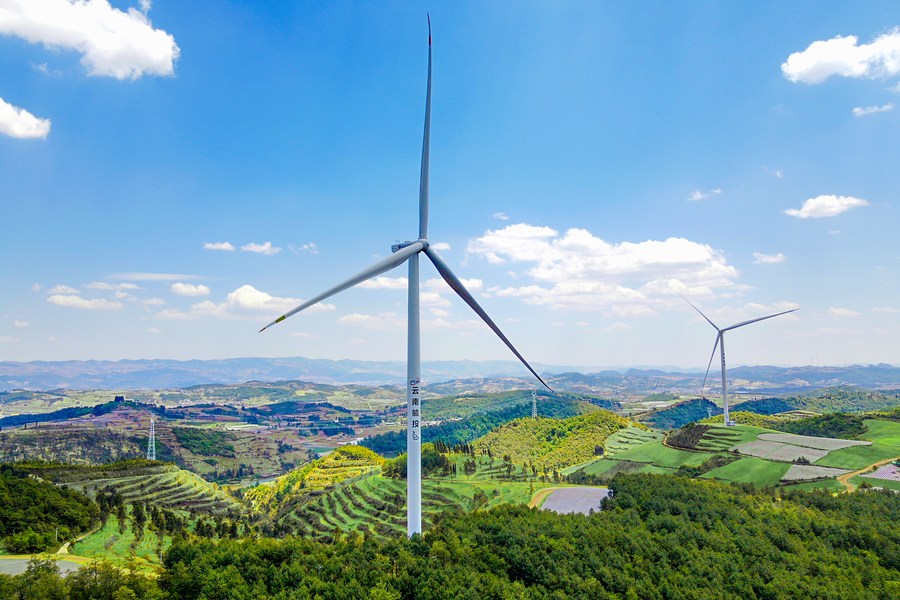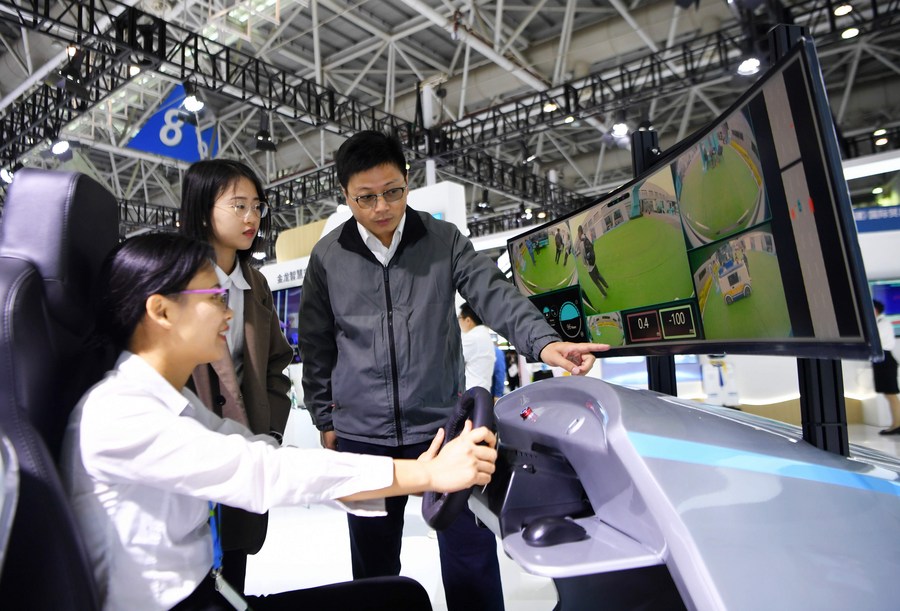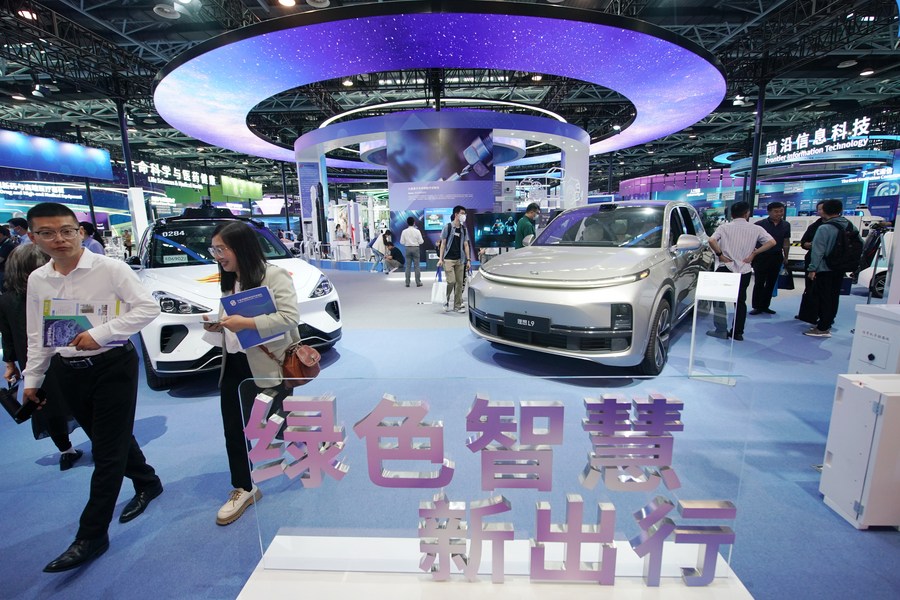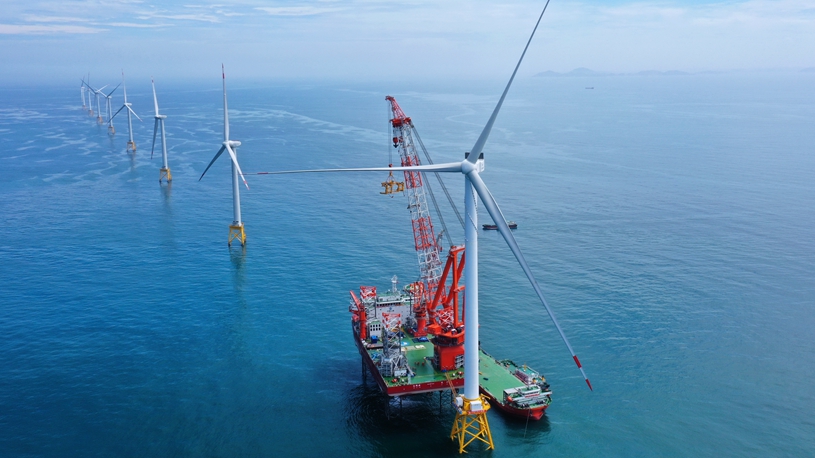
This aerial photo taken on May 16, 2023 shows wind turbines of Honghe Yongning wind power plant in Honghe Hani and Yi Autonomous Prefecture, southwest China's Yunnan Province. (Yunnan Provincial Energy Investment Group/Handout via Xinhua)
* Behind the baseless accusation of China stealing American companies' technologies lurks the politically motivated U.S. scheme to contain China's scientific and technological development.
* Over the past few decades, China has made historic strides and progress in the field of science and technology.
BEIJING, July 20 (Xinhua) -- The United States has once again recycled the groundless accusation of "China stealing intellectual property," in an attempt to further its agenda of suppressing China's scientific and technological strength.
However, international experts have pointed out that China's achievements in scientific and technological innovation are indisputable. The narrative of "China stealing intellectual property" lacks any factual basis and is nothing more than a politically motivated ploy concocted by some Western countries.
CLIMBING RANKING
Over the past few decades, China has made historic strides and progress in the field of science and technology.
According to a recent report published by the World Intellectual Property Organization (WIPO), the China National Intellectual Property Administration received 1.59 million patent applications in 2021, ranking first among the about 150 countries and regions worldwide. China also leads the world in the number of trademark applications and industrial design applications.
In 2022, a total of 798,000 invention patents were authorized. By the end of 2022, the total number of valid invention patents in China had reached 4.21 million, of which 3.28 million were held by inventors from the Chinese mainland, said Hu Wenhui, deputy head of the National Intellectual Property Administration, at a press conference earlier this year.
China has not only consistently ranked first globally in terms of intellectual property applications but has also experienced a steady rise in its global innovation ranking in recent years.
According to the annual report of the Global Innovation Index (GII) published by the WIPO, China has shown remarkable progress in innovation since joining the index in 2013 at an initial rank of 35th. Every year since then, China has steadily climbed the rankings. In 2020, 2021, and 2022, China achieved rankings of 14th, 12th, and 11th respectively, demonstrating its consistent upward trajectory in global innovation.
Commending China's achievements and progress on intellectual property over the past decades, WIPO Director General Daren Tang recently said that China's intellectual property strategy is exemplary.

A visitor tries to operate a vehicle supported by King Long 5G technology at an exhibition of the 6th Digital China Summit in Fuzhou, southeast China's Fujian Province, April 26, 2023. (Xinhua/Wei Peiquan)
SOUND INNOVATION ECOSYSTEM
A consistent innovation policy, increased spending on education and science and the ability to translate all these into sound results are behind China's current role as a global innovation leader, said Sacha Wunsch-Vincent, head of Section, Economics and Statistics Division at the WIPO.
"The speed with which China has built well-known high-tech firms, mostly in the information and communication technology sector or the white goods sector, including large home appliances, etc., which are known around the world, has been impressive," he said.
He underlined that China has overtaken Japan, Germany and the United States in the number of international patent applications by origin, scaled by GDP, and its lead is striking when considered in absolute terms. The same is true for the number of trademarks and industrial designs by origin as a percentage of GDP.
What matters more than the numbers game is the constant pursuit of a "sound, organic innovation ecosystem in China, which is sufficiently connected to the innovation actors of other countries," Wunsch-Vincent said.
Speaking of China's steady climb in the Global Innovation Index ranks, Wunsch-Vincent believes that it is not at all unnatural, as China's policymakers have tried to consistently review and improve on their past innovation policies.
"We can see an effort to improve further, be it in the field of reinforcing science-industry linkages, in further building Chinese innovation clusters, or in putting the huge stock of Chinese intellectual property filings to use via commercialization or cross-licensing," he said.
Francis Gurry, the WIPO's former director general, has said, "We see that a massive structural transformation is underway in the Chinese economy from low-cost labor manufacturing and factories to much higher knowledge-intensive industries, and innovation is the key to the success of that transformation."
Gurry believes that such a key ingredient has engaged and rallied the whole country behind this top-down policy, including state-owned enterprises, private enterprises, universities and research institutions.
The number of scientific publications and international patent applications from China continues to rise, he said.
"All the indicators are positive and follow consistent trends. And I think this policy of a carefully-planned, high-level focus on innovation is part of the key to China's success," he said.

People visit the exhibition center of Zhongguancun National Independent Innovation Demonstration Zone in Beijing, capital of China, May 27, 2023. (Xinhua/Zhang Chenlin)
BASELESS ACCUSATION
Behind the baseless accusation of China stealing American companies' technologies lurks the politically motivated U.S. scheme to contain China's scientific and technological development.
Debunking the "technology theft" rhetoric targeting China, William Jones, Washington bureau chief of U.S. publication Executive Intelligence Review, said that "most of the hype around the so-called technology theft is simply a political gimmick to undercut some of the progress China has made over the last few decades."
China is in the midst of an industrialization process, "a point at which they have the native talent in abundance and the support of the government to move forward at a rapid pace as the world now realizes," he added.
China has emerged as a global leader in multiple domains, including 5G, e-commerce, mobile payment, smartphones, clean energy technologies, and fintech. Moreover, substantial advancements have been made in areas such as AI, electric transportation, and autonomous driving.
There are arguments that linkages with China "facilitate the leakage of our intellectual property," Michael Wesley, deputy vice-chancellor (international) at the University of Melbourne, wrote in an opinion piece titled "Australia must engage with China, our future depends on it."
"This is a view that is both limiting and misinformed," Wesley said. "Chinese researchers don't need collaborations to 'steal' our intellectual property."
According to recent studies referenced in the journal Science, he said, Chinese researchers account for the highest proportion of the most cited scientific papers of any country in the world. "Other studies also show Chinese research is rising fast in innovation and quality."
China's commitment to fostering innovation is evident in its investment in research and development (R&D). According to data published by the National Bureau of Statistics, China's investment in basic research stood at 195.1 billion yuan (about 27.3 billion U.S. dollars) in 2022, accounting for 6.32 percent of the total R&D spending, ranking second globally after the United States.
It's a "common misconception" to view China as a copier, said Robert Atkinson, president of the U.S. Information Technology and Innovation Foundation, "China can and does innovate."■











